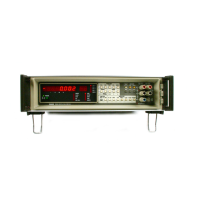8505A
timeout (for settling
delay) may also be inserted
before
each reading. No
filtering is available for the external
reference
input.
2-77. Two methods of filter selection are available.
Selection of any mode (F,
FO, FI, F2, F3)
is possible using
the
STORE
(numeric) FILTER sequence. The FILTER,
push button by
itself toggles between modes F and FO.
The slow
filter (F) is always selected when a toggle is
performed
with a fast filter (FO, FI, or F3) in effect. The
fast
filter (FO) is always
selected when
a
slow filter
(F or
F2) is in effect.
Mode FO is preselected at power-up or
reset.
2-78.
AVERAGING
2-79. The
Averaging mode presets the sample setting
to
10
and the filter
mode
to
F to provide optimum stability
and resolution
throughout the range of inputs.
Subsequent
FILTER or SAMPLE selection may
jeopardize
this intended optimization. Therefore, sample
settings
less than 10 cause the multimeter to exit the
Averaging mode. Filter mode F2 can
also
be specified
while
in the Averaging mode. Selection of any
filter
other
than F
or F2 is accepted by
the multimeter,
but causes
deactivation of Averaging mode.
2-80.
The
Averaging
mode can be used to improve
display
stability
(reduce rattle) in all ranges and
to
increase
display
resolution in
certain
ranges. Preset
resolutions
used
for
standard
operation and
for the
Average
mode
are
summarized in
Table
2-5.
2-81. RANGE
2-82. Ranges
available in each function are summarized
in
Table
2-3.
A
power-up or reset condition sets the
multimeter
in the
1000V
range,
Autoranging disabled.
Each
function selection
enables Autoranging (AUTO
annunciator on). In
Autoranging, the multimeter selects
the
range offering
maximum resolution for the measured
value.
The AUTO
(range) push button toggles
Autoranging
mode on or off. When toggling off, no range
change is
effected. Either of the up/ down push buttons
select
manual ranging and step up/
down one range when
initially
used.
Each subsequent use steps to the next
higher/ lower range
(if available).
2-83. V DC
AND OHMS ZERO
2-84.
In VDC or
OHMS, internal dc drift may be
corrected
by
zeroing. If Calibration mode
is off, the
values are
stored in a temporary memory and do
not
affect Calibration
Memory entries. The value stored at a
zero
input level is used as a zero
correction for the
selected
range and for all higher ranges in
the same
function. Separate zero
values for each range can thereby
be
stored by starting with the lowest
range and working
up.
Calibration Memory values are automatically
loaded
into the temporary
memory when power-up or reset
occurs. The Temporary memory
values are reset to zero
when power-up or reset occurs. In this
case, each zero
value
stored does not affect values on any other range.
Table
2-S.
Resolution
RANGE
NORMAL AVERAGING
DIGITS DIGITS
V
DC 100 mV
6V
2
6V2
IV 6V
2 6Y2
10V
6
Vz
IV2
100V
6
V2
6V2
1000V
6
Vz
6V2
V AC,
IV
5’/
2 6Vs
OR 10V 5 Vz 6V2
V AC + V DC 100V 5V2 6V2
1000V 5V
2
6V
2
A DC
100 fjA
5V2
6Vfe(5V2 A AC)
or 1
mA
5’/
2
6V
2
A AC
10 mA 5V2 6V2
100
mA
5V
2
6
V2
1
A
5V2 6V2
OHMS
10Q 5V2
m
100Q 5Vz 6V
2
1 kQ 6V2
6'/
2
10 kO 6
V
2 6V2
100 kQ 6Vi 6V2
1 MQ
5Vz
6V2
10 MO 5V2 6V2
100
MO
5%
6
V2
2-85.
Good
quality, low thermal shorting bars (not
shorted
test leads) must be applied between INPUT HI
and
LO terminals during
the zero operation. Initial
use of
the ZERO
V DC/OHMS push button stores the zero
correction value and activates the Zero mode (ZERO
annunciator lights).
Pressing
ZERO
V
DC/' OHMS a
second
time deactivates
the Zero
mode (ZERO
annunciator goes
off). A new zero value is entered
each
time the
mode is enabled. Scaling
and
offset values are
ignored in the stored
correction value. Attempting
to
store zero
in
an
illegal function (A DC, A AC, or V AC)
results in an Error 0
indication. Exiting
the zeroed
function deactivates
the Zero mode, but retains the stored
values. Upon
reentering the zeroed function, Zero mode
and the old
value are automatically restored. The zero
value can be
recalled for the selected
range
and function
(VDC
or OHMS).
2-86. Mathematic Operations
2-87. Mathematic operations can be specified to change
the measured value (as
influenced
by measurement
parameters)
before it is actually displayed.
Ratio,
deviation, percentage variation and other mathematically
manipulated
displays are thereby possible. Scaling (or
External Reference) can
be
used to
divide
the measured
2-22

